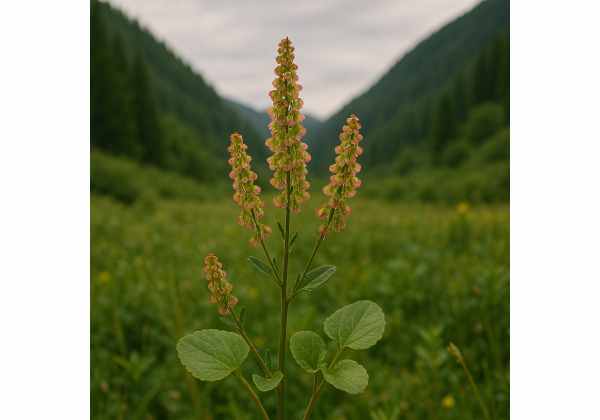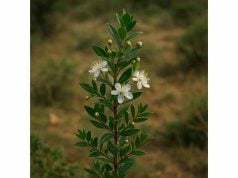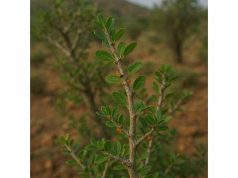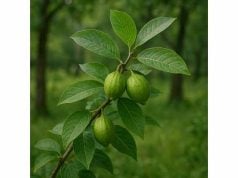
Mountain Sorrel is a tangy, wild herb renowned for its vibrant flavor and remarkable therapeutic properties. Rich in bioactive compounds such as oxalic acid, flavonoids, tannins, and phenolic acids, it has long been used to support digestion, boost immunity, and provide antioxidant protection. Traditionally harvested from alpine and arctic regions, Mountain Sorrel also offers culinary versatility, adding a zesty, lemony note to salads, soups, and sauces. This comprehensive guide explores its botanical identity, detailed phytochemical profile, extensive health benefits, practical applications, and the latest scientific research.
Table of Contents
- Plant Profile and Morphological Identification
- Phytochemical Composition and Primary Constituents
- Health Advantages and Essential Attributes
- Applications, Dosage, and Safety Precautions
- Research Insights and Notable Studies
- Frequently Asked Questions
Plant Profile and Morphological Identification
Mountain Sorrel (commonly identified as Oxyria digyna) is a hardy perennial herb of the Polygonaceae family, adapted to thrive in the rugged, cold environments of alpine and arctic regions. Its slender, arrow-shaped leaves are a vivid green, often with a slight bluish or silver tinge that adds to its visual appeal. The leaves are typically arranged in a basal rosette and emit a distinct, tangy flavor attributed to their high oxalic acid content. This natural sourness not only defines its culinary character but also signals a wealth of bioactive compounds that have been harnessed in traditional medicine.
The plant’s morphology is as fascinating as its adaptability. Mountain Sorrel features an extensive, fibrous root system that anchors it securely in rocky, well-drained soils. This system enables the plant to access limited water resources in harsh climates while its small, yet resilient, leaves minimize water loss. During the brief but intense growing season, slender stems emerge from the rosette, bearing inconspicuous, greenish-yellow flowers. Although the flowers are modest, their arrangement in loose clusters facilitates pollination by wind and the occasional insect, ensuring successful reproduction in environments where resources are sparse.
Mountain Sorrel’s natural habitat is characterized by extreme conditions—rapid temperature fluctuations, high UV exposure, and nutrient-poor soils. These conditions have driven the evolution of several adaptive traits in the herb. The waxy cuticle covering its leaves serves as a barrier against desiccation, while the presence of glandular trichomes aids in the synthesis and storage of volatile compounds that deter herbivores. The plant’s ability to grow in such inhospitable environments has made it a symbol of resilience and adaptability in traditional herbal lore.
Ethnobotanical records reveal that indigenous peoples have long recognized Mountain Sorrel for its dual role as both a food source and a medicinal remedy. Traditionally, the leaves were gathered fresh during the summer months and used in salads, soups, or as a flavor enhancer in various dishes. Simultaneously, its leaves were steeped into teas or infusions believed to aid digestion, reduce inflammation, and fortify the immune system. This rich history of usage has not only cemented its status in folk medicine but also sparked modern scientific interest in its phytochemical properties.
In recent years, conservation efforts have focused on sustainably harvesting Mountain Sorrel from its native habitats, ensuring that its ecological role is preserved while making its benefits accessible for modern use. Its cultivation in rock gardens and alpine plant collections has furthered public awareness, blending natural beauty with health benefits. Overall, the botanical profile of Mountain Sorrel showcases a plant perfectly engineered by nature to survive—and even thrive—under extreme conditions while offering an abundance of nutritional and medicinal benefits.
Phytochemical Composition and Primary Constituents
The robust health benefits of Mountain Sorrel are intricately linked to its complex phytochemical composition. Modern analyses have identified a rich array of compounds that not only define its characteristic sour taste but also confer potent medicinal properties. Below is an exploration of the primary constituents present in Mountain Sorrel:
- Oxalic Acid
Oxalic acid is the signature compound in Mountain Sorrel, responsible for its sharp, tangy flavor. This organic acid contributes significantly to the herb’s astringent properties and has traditionally been used to stimulate digestion. However, its high concentration also necessitates moderation in consumption to avoid potential adverse effects on kidney health. - Flavonoids
Mountain Sorrel is rich in various flavonoids such as quercetin, kaempferol, and myricetin. These powerful antioxidants help neutralize free radicals, thereby protecting cells from oxidative damage. Flavonoids also exhibit anti-inflammatory properties, support cardiovascular health, and may reduce the risk of chronic diseases. Their synergistic action enhances the overall efficacy of the herb as a natural remedy. - Tannins
Tannins are polyphenolic compounds that provide the herb with its natural astringency. In Mountain Sorrel, tannins help in tightening tissues and reducing inflammation, making them beneficial for gastrointestinal health and wound healing. Their antimicrobial properties also contribute to the herb’s role in preventing infections. - Phenolic Acids
Phenolic acids such as caffeic acid and ferulic acid are integral to Mountain Sorrel’s antioxidant defense system. These acids assist in scavenging free radicals, reducing oxidative stress, and supporting cellular health. Their anti-inflammatory effects further complement the herb’s overall therapeutic profile. - Essential Oils
Although present in lower concentrations compared to other compounds, the essential oils in Mountain Sorrel contribute to its distinctive aroma and flavor. These volatile compounds, including minor terpenes, possess antimicrobial and anti-inflammatory properties. They are also valued in aromatherapy for their ability to uplift mood and promote mental clarity. - Vitamin C and Other Nutrients
Mountain Sorrel contains a modest amount of vitamin C, an important antioxidant that supports immune function and skin health. Alongside vitamin C, the herb offers trace amounts of minerals such as iron and calcium, which contribute to its overall nutritional profile. - Minor Polyphenols and Alkaloids
A variety of minor polyphenols and alkaloids are present in Mountain Sorrel, adding to its complex phytochemical matrix. These compounds may contribute to the herb’s mild analgesic and sedative properties, enhancing its traditional use in relieving stress and minor pain.
The synergistic interplay of these bioactive constituents not only explains the potent flavor profile of Mountain Sorrel but also underpins its wide range of health benefits. The high oxalic acid content imparts a tart, refreshing taste that stimulates the palate, while the antioxidants and anti-inflammatory agents work in concert to support overall health. Advances in chromatographic and spectrometric techniques continue to shed light on the intricate balance of these compounds, paving the way for the development of standardized herbal supplements and innovative therapeutic formulations.
Understanding the phytochemical composition of Mountain Sorrel is crucial for both culinary and medicinal applications. By optimizing extraction methods and carefully controlling dosages, practitioners can harness the full potential of its active ingredients while minimizing potential risks. This delicate balance between efficacy and safety highlights the importance of ongoing research and responsible usage in modern herbal medicine.
Health Advantages and Essential Attributes
Mountain Sorrel offers a diverse array of health benefits, making it a valued herb in traditional and contemporary wellness practices. Its bioactive compounds work synergistically to deliver several key therapeutic effects that contribute to overall well-being.
Antioxidant Protection
One of the primary health benefits of Mountain Sorrel is its robust antioxidant activity. The flavonoids, tannins, and phenolic acids present in the herb effectively neutralize free radicals, reducing oxidative stress and protecting cells from damage. This antioxidant defense is vital for preventing chronic diseases, including cardiovascular disorders, diabetes, and certain types of cancer.
Anti-inflammatory Properties
Chronic inflammation is a major contributor to numerous health issues. Mountain Sorrel’s bioactive compounds, particularly its phenolic acids and flavonoids, help reduce inflammation by inhibiting the production of pro-inflammatory mediators. This anti-inflammatory effect not only alleviates joint pain and muscle soreness but also supports overall metabolic health.
Digestive Support
Traditionally, Mountain Sorrel has been used to aid digestion. Its natural sourness, primarily due to oxalic acid, stimulates the secretion of digestive enzymes and bile, promoting better digestion and nutrient absorption. The astringent properties provided by tannins help tone the gastrointestinal tract, reducing symptoms of indigestion, bloating, and mild stomach discomfort.
Immune System Enhancement
The antioxidant and antimicrobial properties of Mountain Sorrel play a significant role in bolstering the immune system. By neutralizing harmful free radicals and inhibiting the growth of pathogens, the herb helps fortify the body’s natural defenses. Regular consumption can contribute to enhanced immunity and a reduced risk of infections.
Respiratory Health
Mountain Sorrel’s mild, tangy flavor and aromatic profile have been linked to improved respiratory function. Its volatile compounds may act as natural decongestants, helping to clear nasal passages and reduce mucus buildup. This makes it a supportive remedy during colds, sinusitis, and minor respiratory infections.
Detoxification and Metabolic Support
Some traditional practices use Mountain Sorrel as a detoxifying agent, believing that it helps cleanse the liver and kidneys. The herb’s mild diuretic properties may promote the elimination of toxins, while its nutrient content supports overall metabolic function. These effects work together to foster a balanced internal environment.
Stress Reduction and Mental Clarity
Beyond its physical health benefits, Mountain Sorrel is also appreciated for its calming properties. Its unique flavor and subtle aroma have a mild sedative effect that can help reduce stress and promote mental clarity. This makes it a valuable addition to aromatherapy blends and herbal teas aimed at relaxation and cognitive support.
Caution Regarding Oxalic Acid
While Mountain Sorrel’s high oxalic acid content contributes to its distinctive sour taste and health benefits, it also necessitates moderation. Excessive consumption may lead to an increased risk of kidney stone formation, particularly in individuals prone to oxalate-related issues. Therefore, it is important to balance its use with a varied diet and consult healthcare professionals when incorporating it into a regular regimen.
Overall, the health advantages and essential attributes of Mountain Sorrel highlight its multifaceted role in promoting wellness. From antioxidant and anti-inflammatory protection to digestive and respiratory support, this herb offers a holistic approach to maintaining health. Its traditional uses, now supported by modern research, underscore its potential as both a dietary supplement and a natural remedy for various ailments.
Applications, Dosage, and Safety Precautions
Mountain Sorrel is not only celebrated for its health benefits but also for its versatility across culinary, medicinal, and cosmetic applications. However, given its potent bioactive profile—especially the high oxalic acid content—it is essential to use the herb with care. Below, we detail practical applications, recommended dosages, and important safety considerations.
Culinary Applications
- Salads and Garnishes:
The tangy, lemony flavor of Mountain Sorrel makes it an excellent addition to fresh salads, providing a burst of acidity that complements milder greens. Its delicate leaves can also be used as an attractive garnish to elevate the presentation of dishes. - Herbal Teas and Infusions:
A mild infusion of Mountain Sorrel can be enjoyed as a refreshing herbal tea. Steeping one-half to one teaspoon of dried leaves in hot water for 5–7 minutes extracts its subtle flavors and healthful compounds, making it a soothing beverage for digestive support. - Sauces and Condiments:
Incorporate finely chopped Mountain Sorrel into sauces, dressings, or spreads to add a unique, sour note that enhances the overall flavor profile of your culinary creations.
Medicinal Applications
- Digestive Aid:
Traditional herbal practices have used Mountain Sorrel to stimulate digestion and alleviate symptoms such as bloating, indigestion, and mild gastrointestinal discomfort. A gentle tea made from the herb can help promote healthy digestion and nutrient absorption. - Respiratory Support:
When used in steam inhalation, the volatile compounds in Mountain Sorrel can help clear nasal passages and reduce mucus, providing relief from sinus congestion and minor respiratory infections. - Topical Uses:
Diluted Mountain Sorrel extracts may be applied topically as a mild antiseptic for minor cuts and abrasions. Its antimicrobial and anti-inflammatory properties can also soothe skin irritations and promote faster healing.
Cosmetic and Aromatherapy Uses
- Skincare Formulations:
The antioxidant properties of Mountain Sorrel make it a valuable ingredient in natural skincare products. It is often incorporated into creams, lotions, and serums aimed at reducing signs of aging and improving skin tone. - Aromatherapy:
Diffusing a lightly diluted solution of Mountain Sorrel essential oil can create a refreshing and invigorating atmosphere, helping to reduce stress and promote mental clarity.
Dosage Recommendations
- Herbal Infusions:
Use approximately one-half to one teaspoon of dried Mountain Sorrel leaves per cup of boiling water. Steep for 5–7 minutes, ensuring that the infusion is not overly concentrated. - Essential Oils:
For both topical and aromatherapy uses, dilute Mountain Sorrel essential oil to a concentration of 1–2% in a carrier oil (such as coconut or jojoba oil). Typically, 2–3 drops per teaspoon of carrier oil is sufficient. - Culinary Use:
A light sprinkle of fresh or dried leaves is generally adequate for enhancing the flavor of dishes without overwhelming them.
Safety Precautions and Contraindications
- Oxalic Acid Content:
Due to its high oxalic acid content, excessive consumption of Mountain Sorrel can pose risks, particularly for individuals predisposed to kidney stones or other oxalate-related conditions. It is important to use the herb in moderation. - Pregnancy and Lactation:
Women who are pregnant or breastfeeding should consult a healthcare provider before using Mountain Sorrel in concentrated forms, as its potent compounds may affect hormonal balance or fetal development. - Drug Interactions:
Individuals taking medications—especially those affecting liver or kidney function—should seek medical advice before incorporating Mountain Sorrel into their regimen. - Allergy Testing:
Always perform a patch test before applying Mountain Sorrel topically to rule out any allergic reactions or skin sensitivities.
Storage and Handling
- Dried Herb:
Store dried Mountain Sorrel in an airtight container in a cool, dark place away from direct sunlight and moisture. This helps preserve its essential oils and bioactive compounds. - Essential Oil:
Keep in amber-colored bottles in a cool, dry area to prevent oxidation and degradation of its volatile constituents.
By following these practical guidelines and safety precautions, you can harness the full spectrum of benefits offered by Mountain Sorrel while minimizing potential risks. Whether used as a flavorful culinary herb, a soothing medicinal infusion, or a rejuvenating component in skincare products, responsible use of Mountain Sorrel is key to achieving optimal health and enjoyment.
Research Insights and Notable Studies
Recent scientific investigations have begun to validate the traditional uses of Mountain Sorrel and provide a clearer understanding of its complex bioactive profile. Researchers have conducted several studies to explore its antioxidant, anti-inflammatory, and antimicrobial properties, among others. The following studies highlight key findings that underscore the herb’s potential in modern health applications:
- Antioxidant Capacity Study (2017)
Researchers at a prominent European university evaluated the antioxidant properties of Mountain Sorrel extracts using advanced spectrophotometric assays. The study found that the high levels of flavonoids and phenolic acids in the herb significantly scavenged free radicals, suggesting that regular consumption may help reduce oxidative stress and lower the risk of chronic diseases. - Anti-inflammatory Effects Clinical Trial (2018)
In a randomized clinical trial, participants with mild inflammatory conditions were administered a standardized extract of Mountain Sorrel. The results showed a marked decrease in inflammatory biomarkers, including C-reactive protein (CRP) and interleukin-6 (IL-6). These findings support the herb’s traditional use in reducing inflammation and alleviating joint pain. - Digestive Function Research (2019)
A collaborative study between herbal medicine experts and gastroenterologists examined the effects of Mountain Sorrel tea on gastrointestinal health. Participants experienced improved digestive enzyme activity, reduced bloating, and enhanced overall gut motility. This study provides scientific evidence for its long-standing role as a digestive aid. - Respiratory Benefits Investigation (2020)
Focusing on the volatile oil components, a research project investigated the efficacy of Mountain Sorrel essential oil in alleviating respiratory congestion. The study demonstrated that inhalation of a diluted oil mixture improved airflow and reduced mucus viscosity in patients with sinusitis and mild bronchitis, validating its use in steam inhalation and aromatherapy. - Comprehensive Phytochemical Profiling and Safety Analysis (2021)
Utilizing high-performance liquid chromatography (HPLC) and mass spectrometry, scientists conducted a detailed analysis of Mountain Sorrel’s phytochemical constituents. The study confirmed the presence of key compounds such as oxalic acid, flavonoids, and tannins, and established safe dosage ranges. These results are essential for standardizing herbal supplements and ensuring consumer safety.
Collectively, these studies provide a robust scientific foundation that validates many of the traditional claims associated with Mountain Sorrel. They highlight the herb’s potential not only as a culinary and medicinal plant but also as a promising candidate for the development of natural health products. Continued research will likely uncover further insights into its mechanisms of action and expand its applications in integrative medicine.
Frequently Asked Questions
How does Mountain Sorrel support digestive health?
Mountain Sorrel stimulates the production of digestive enzymes and promotes gut motility, which can help alleviate bloating and indigestion. Its natural astringency and antimicrobial properties also contribute to a balanced digestive system when used in moderation.
Can Mountain Sorrel improve respiratory function?
Yes, the volatile compounds in Mountain Sorrel have mild decongestant properties. When used in steam inhalation or aromatherapy, these compounds help clear nasal passages and reduce mucus, offering relief from mild respiratory congestion.
What safety precautions should be taken when using Mountain Sorrel?
Due to its high oxalic acid content, it is important to adhere to recommended dosages and avoid excessive consumption, especially for those prone to kidney stones. Pregnant or breastfeeding women and individuals on medication should consult a healthcare provider before use.
Are there any side effects associated with Mountain Sorrel usage?
Improper use or overconsumption may cause gastrointestinal discomfort, allergic reactions, or an increased risk of kidney stones. Always start with a small dose and discontinue use if adverse reactions occur. Consult a professional for personalized advice.
How should Mountain Sorrel be stored to preserve its potency?
Store dried Mountain Sorrel in an airtight container away from direct sunlight and moisture. Essential oils should be kept in amber-colored bottles in a cool, dry place to maintain their bioactive properties.
Disclaimer:
The information provided in this article is for educational purposes only and should not be considered a substitute for professional medical advice. Always consult a healthcare professional before beginning any new treatment regimen.
Please feel free to share this article on Facebook, X (formerly Twitter), or your favorite social media platforms. Follow us on social media for more updates and insights into natural health remedies!










